The week at a glance
- Glaucous-winged Gull still in Cleveland
- Canvasback in Argyll
- Pine Bunting in Cornwall
- Killdeer in Norfolk
- Possible Wilson's Snipe on Scilly
- Possible Pacific Diver in County Galway
2009 seemed reluctant to relinquish the rarity reins as the second full week of the New Year galloped off into the greyness of a new and occasionally damp weather system — collecting a whole host of top-notch fodder along the way. It seems a shame that all that old-fashioned cold and frosty winter weather has gone, replaced by brisk, relatively mild southwesterlies. No matter, the rarities on offer were of the highest order.
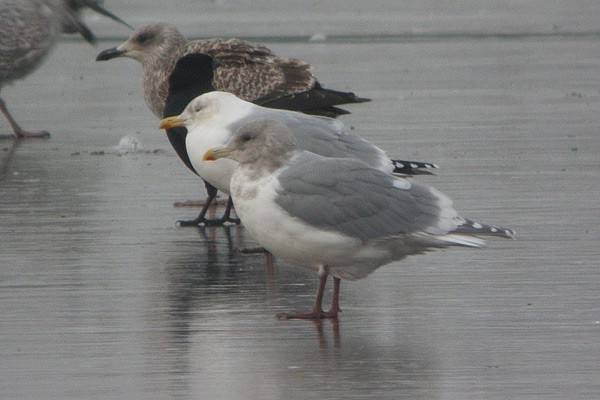
Glaucous-winged Gull, Saltholme Pools RSPB, Cleveland (Photo: Tristan Reid)
Top of the bill was still the adult Glaucous-winged Gull that continued its stay on Teesside. This magnificent über-gull was seen daily from 8th–10th and then took its leave again (as the weather changed and the local tips were closed on 11th). The bird favoured the areas around Dorman's Pool and the Reclamation Pond before dropping in on the Saltholme Pools RSPB reserve, a loose pattern that the bird stuck to on the three days of the week it was present (departing around midday on 10th). Many birders have now had the chance to lay this demon to rest and, until the Great-black-headed Gull, Slaty-backed Gull or Black-tailed Gull appears, it may well prove to be the most-twitched British gull in history. Less popular (if only because of the out-of-the-way location) was the female Canvasback that remained at the head of Loch Indaal, Islay (Argyll) to 8th. As mentioned previously in Weekly Reviews, this species (along with Redhead) has fallen under the watchful eye of a national committee or two, so quite what the future holds for the two species is open to question — maybe this will become a British first at the end of it all! Talking of "firsts", the first Cornish Pine Bunting, a male, was seen at Nanjizal on 9th, flying away from Trevilly Farm towards Lower Bosistow Farm, never to be seen again. Needless to say, the species is desperately rare in the far southwest — Devon has one and Scilly two (including the famous golf-course spring male in 1985) and there hasn't been a twitchable mainland bird since the winter Worcestershire male in January 2005. In Norfolk, a Killdeer was found by birders twitching Smew along the channel at Saddle Bow near King's Lynn on 11th. On paper, this represents the third Killdeer for the county, following records in March 2005 and April 2006 (which surely were the same bird?). The 2009 bird wasn't around for too long though, departing to the southwest...Cambridgeshire listers ought to keep an eye open over the next few days. On Scilly, at Lower Moors on St. Mary's, a possible Wilson's Snipe was seen on 10th–12th, while a potential first for Ireland, a possible adult Pacific Diver, was seen (and videoed) off Tawin (Co. Galway) on 12th.
A Sooty Shearwater was seen from St. Ives (Cornwall) on 12th with another reported in Carbis Bay (Cornwall) on 14th. One or two south-coast Balearic Shearwaters were also seen this week, along with the occasional Pomarine Skua. Red-throated Diver is a species that barely ever warrants a mention in the Weekly Review, but a county-record count of 1,814 past Eccles-on-Sea (Norfolk) on 9th is certainly of note. However, with pelagic fare registering just shy of "minimal" this week, it's straight on to egrets...
Cattle Egrets were again proving reasonably popular in the southwest of England and Ireland this week. At least one bird remained around St. Mary's (Scilly) on 8th–14th, while in Cornwall, up to five birds were around Polgigga from 8th–14th and three birds were at Nanjizal on 9th. In Devon, at least two birds were seen around the Kingsbridge Estuary from 8th–12th, two more remained at Exminster Marshes to 9th and one was at Ivybridge on 13th. In Somerset, two birds were seen at Wall Common and another was at Taunton, all on 10th. Across to Kent, where a Cattle Egret was seen at Herne Bay on 11th, the only English record away from southwestern counties. In County Cork, a number of Cattle Egrets remained in place, with up to six birds remaining around Beamish's Pool, Inchydoney Island to 12th at least, one near Rossleague on 9th, and two more at Rossmore on the same date. On 10th, four birds were seen near Timoleague (still present on 12th), two were again at Boonagh near Rosscarbery (remaining to 13th at least) and two were seen at Great Island near Belvelly. Elsewhere in the Republic, three Cattle Egrets were at Ballyduff (Co. Waterford) on 10th, when two more were seen west of Carnsore Point (Co. Wexford).

Spoonbill, Warleigh Point, Devon (Photo: Phil Stidwill)

Night Heron, Hythe, Kent (Photo: Mike Lawrence)

Common Crane, Waxham, Norfolk (Photo: Ross Coupland)
Five Great White Egrets were reported this week: one flew over Fen Drayton Lakes (Cambridgeshire) on 8th, when one was also seen (again) at Shapwick Heath (Somerset). On 10th, last week's bird at The Brooks (East Sussex) reappeared while in Hampshire the bird at Blashford Lakes remained to 14th. A further Great White Egret was seen in flight near Westbury (Wiltshire) on 13th. In Devon, five Spoonbills were on Isley Marsh at the start of the week, and were followed by singles at Dawlish Warren and Axmouth, and two off Warleigh Point, all on 11th. Singles in Dorset on 9th were seen at Radipole Lake and Holes Bay, followed by two or three in and around Poole Harbour on 11th. Also on 11th, single Spoonbills were seen at Cliffe Pools (Kent) and Wat Tyler CP (Essex) while two birds were seen on a cruise up the River Tamar (Cornwall). A Spoonbill remained on Samson (Scilly) to 13th. In Wales, single Spoonbills were noted at Lawrenny (Pembrokeshire) on 9th–14th and at the National Wetlands Centre (Carmarthenshire) on 12th. The adult Night Heron was still to be found on the Royal Military Canal at Hythe (Kent) from 9th–14th while the only Common Cranes reported in the week were in the Norfolk Broads, seen on a daily basis. In Essex, the Spotted Crake was reported as calling again at the Warren Gorge reserve near Chafford Hundred on 12th–13th (it was last heard on 3rd).

Red-breasted Goose, Keyhaven Marshes, Hampshire (Photo: Steve Copsey)
The popular wintering adult Red-breasted Goose was still in situ around Keyhaven Marshes (Hampshire) until 13th at least. The Cackling Canada Goose remained in the general area around Caerlaverock (Dumfries & Galloway) to 13th and a Taverner's Canada Goose was seen near Kelton (Dumfries & Galloway) early on 10th, with it or another at Caerlaverock later the same day. Also at Caerlaverock on 10th was a Richardson's Canada Goose, completing an impressive hat-trick for the site for that date. On Islay, another Richardson's Canada Goose was seen, at Loch Gruinart, on 8th, while a Todd's Canada Goose (form interior) was seen on Tiree, at Balephetrish to 13th at least. The Norfolk Ross's Goose moved into the Broads, being seen near Waxham Sands on 11th. In Ayrshire, the white Snow Goose was at Martnaham Loch on 10th, then near Ayr on 11th–13th, and another was seen again at Loch of Strathbeg (Aberdeenshire) on 13th. At least six Black Brants remained in Norfolk this week: three birds were still to be seen around Wells and Holkham, two more were roaming between Langham, Cockthorpe and Morston, while a single bird was again at Titchwell. At least two birds were in Hampshire during the week, at Farlington Marshes, Gosport and Keyhaven Marshes, and two were together at Pagham Harbour (West Sussex) on 10th. Single Brants were seen at Reculver (Kent) on 9th–13th, The Fleet (Dorset) on 10th–13th and Old Hall Marshes (Essex) on 11th, while in Ireland, single Brants were at Belmullet (Co. Mayo) on 8th and Dungarvan (Co. Waterford) on 12th.

Lesser Scaup, Loch Skerrols, Islay, Argyll (Photo: Jim Dickson)
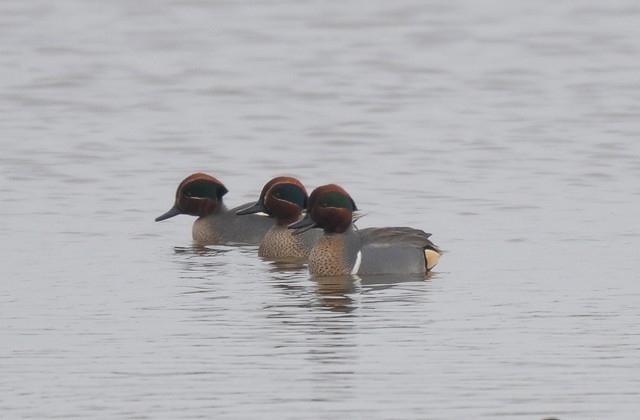
Green-winged Teal, Minsmere RSPB, Suffolk (Photo: Jon Evans)
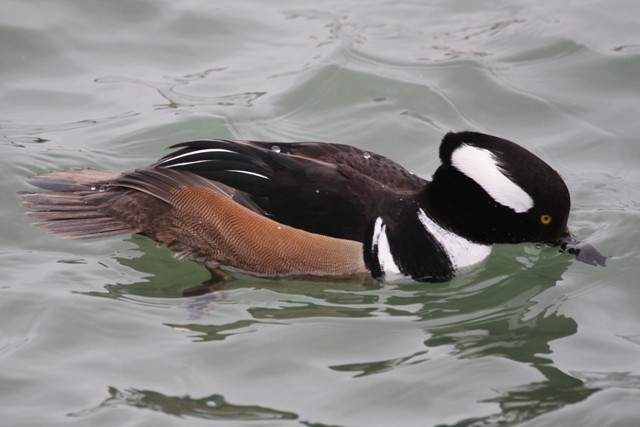
Hooded Merganser, Radipole Lake RSPB, Dorset (Photo: Steve Carey)
With many birders returning to work there was a distinct downturn in the reports of some species, and this week one of the prime examples was Lesser Scaup. Last week's review saw nine birds featured; this week just three were reported: a female was found at Loch Skerrols, Islay (Argyll) on 9th, the first-winter drake remained in Cardiff Bay (Glamorgan) to 14th and the adult drake was seen again at Holme Pierrepoint (Nottinghamshire) on 13th. Ring-necked Ducks this week included up to four birds on Tiree (Argyll): an adult drake was on Loch Bhasapol on 12th, when two first-winter drakes were seen at Loch Riaghain, and a drake had been seen at Loch an Eilein to 9th. A new drake was on Loch Calder (Highland) on 12th, while elsewhere in Scotland, the female Ring-necked Duck was again at Martnaham Loch (Ayrshire) on 8th–12th. The first-winter drake remained at Bordon (Hampshire) from 9th–11th and adult drakes remained at Cwm Rheidol Reservoir (Ceredigion) to 10th and Foxcote Reservoir (Buckinghamshire) to 13th. In Ireland, it was County Clare that dominated the Ring-necked Duck proceedings: a single bird (a drake) was at Lough Inchiquin on 8th, rising to three birds (two drakes and a duck) on 9th and four birds (three drakes and a duck) there on 10th (two drakes remained to 14th). Elsewhere in Clare, a drake Ring-necked Duck was at Ballyallia Lake on 8th–10th and another drake was seen on Lough Gash Turlough, also on 10th. A female remained on The Gearagh (Co. Cork) to 10th. A belated report from 7th was of a drake Ferruginous Duck at Cheddar Reservoir (Somerset), while this week, the drake Ferruginous Duck reappeared at Eagle Lane GPs, Whisby Pits (Lincolnshire) from 9th–11th, reappearing on 14th, with a second drake noted at Oxford Island (Co. Armagh) on 13th. Drake American Wigeon remained at Caerlaverock (Dumfries & Galloway) and Lower Farm GP (Berkshire) this week (to 10th and 14th respectively) while numbers of Green-winged Teal dropped from 20 or so last week to 11 this week. Three birds were in Lancashire on 11th (at Marshside, Freckleton and on the Wyre Estuary) and four birds were seen in Scotland: at Tain (Highland) to 9th, Montrose Basin (Angus) to 11th, Capringstone Flash (Ayrshire) to 13th and Kinneil Lagoons (Forth) to 14th. Back in England, singles were at Shapwick Heath (Somerset) and Minsmere (Suffolk) on 11th–14th and at Edderthorpe Flash (South Yorkshire) to 12th. In Ireland, a Green-winged Teal was at Kilbrittain (Co. Cork) on 12th (having been seen for almost a fortnight beforehand) and one remained at Kilcoole (Co. Wicklow) to 12th–14th. The first-winter drake Surf Scoter was seen off Seaton Hole (Devon) on 8th, before drifting back towards Beer on 11th–13th. Also in Devon, the wintering adult female was still off Dawlish Warren throughout the week, while other wintering regulars included the drake off Lower Largo Bay and Ruddon's Point (Fife) and single females in Hough Bay, Tiree (Argyll) and Silver Strand, Galway. A major surprise this week was the drake King Eider found off Pett Levels (East Sussex) on 11th. This was a county first, and the first seen in southeast England since a female was off North Foreland in Kent in October 1996. It is tempting to think that it may be the drake seen in Devon to mid-November 2008 — a bit of a long shot, agreed, but it is a possibility. In Fife, the second-winter drake remained off Kincraig Point to 14th. In County Sligo, the adult female and first-winter drake King Eider remained in Drumcliffe Bay near Lissadell to 12th at least. In Dorset, the Hooded Merganser at Radipole Lake (Dorset) was still present to 11th.
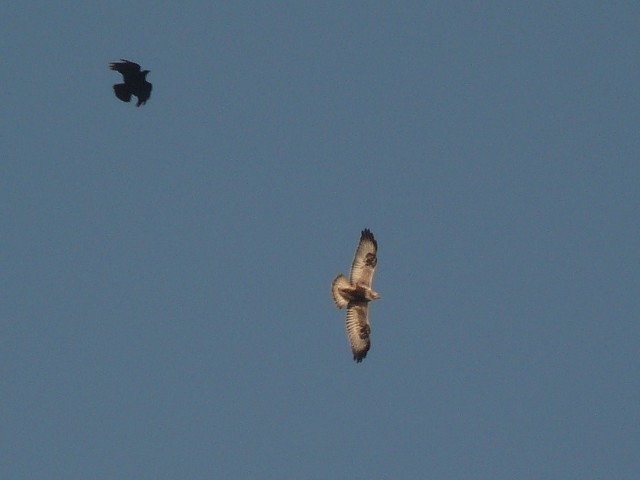
Rough-legged Buzzard, Millington, East Yorkshire (Photo: anon)
The Snowy Owl at Trendrine Hill near Zennor (Cornwall) remained a popular fixture on the year-listing circuit this week — it was seen on 9th–10th and again on 12th–14th. Another Snowy Owl was reported on Westray (Orkney) on 9th, and two different birds have now been noted on the Channel Islands recently (on Alderney and now Guernsey). The Rough-legged Buzzard reported from Gringley Carr in Nottinghamshire was re-identified as a Common Buzzard on 8th. Genuine articles remained at Millington (East Yorkshire) to 8th, Capel Fleet, Isle of Sheppey (Kent) to 11th, Farforth (Lincolnshire) to 12th and Coveney (Cambridgeshire) to 14th and one was seen again near Wighton (Norfolk) on 8th–9th. On 12th–14th, a Rough-legged Buzzard was seen at Sleddale (on the Cleveland/North Yorkshire border), a site where one was seen to mid-March last year.
Once again there was a real dearth of shorebirds this week, with just a handful of Grey Phalaropes to report. One was at Gwithian (Cornwall) on 11th but was taken by a Common Buzzard late in the afternoon, a remarkable event captured on film. Another Grey Phalarope, Buzzard-free and hale and hearty, was seen off Criccieth (Gwynedd) on 12th, along with single Irish birds on the same date off Mizen Head (Co. Cork) and Nethertown (Co. Wexford). The 13th saw three Grey Phalaropes appear off Cot Valley (Cornwall) with another off Filey (North Yorkshire), and on 14th single Grey Phalaropes were seen off Newgale (Pembrokeshire) and Church Norton (West Sussex).
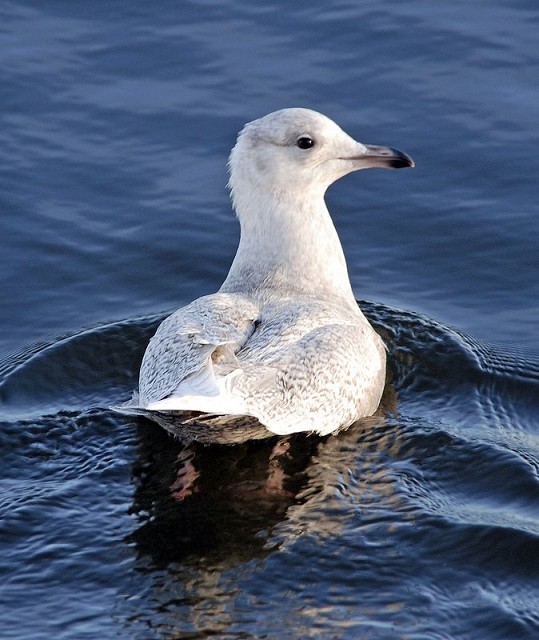
Iceland Gull, Troon, Ayrshire (Photo: Jim Duncan)

Glaucous Gull, Peterhead, Aberdeenshire (Photo: Chris Jones)

Ring-billed Gull, Lamby, Glamorgan (Photo: Jim Almond)
The adult American Herring Gull remained in Galway Docks on 8th and 11th and the presumed second-winter bird was again in Bantry Bay (Co. Cork) on 13th. Some 45 Caspian Gulls were seen during the week, with three birds at Moore NR (Cheshire) on 10th, three at Throckmorton Tip (Worcestershire) on 11th and another trio near Bungay (Norfolk) on 13th (at least eight different birds have been seen in the county this week). Up to four birds were seen around Northamptonshire and four were in Suffolk. A second-winter on the Ugie Estuary (Aberdeenshire) was definitely of note: the species remains very rare in Scotland, with fewer than 10 recorded since the start of the decade. After a huge tally of nearly 140 Iceland Gulls seen over the holiday period, this week saw the numbers take a significant dip: around 85 birds were reported, with nearly 50 in Britain and 35 or so in Ireland. Seven birds were seen at Shetland Catch, Lerwick (Shetland) on 8th (following on from a dozen there on 7th), four birds were seen in the harbour at Troon (Ayrshire) on 10th and five were at Mallaig (Highland) on 11th. In Ireland, nine birds were at Castletown Bearhaven (Co. Cork) on 13th, eight birds were at Killybegs (Co. Donegal) on 10th and four were at Coleraine (Co. Derry) on 11th. Confirmed Kumlien's Gulls this week were a second-winter at Peterhead (Aberdeenshire) on 11th, moving to the Ugie Estuary on 12th, a juvenile at Kirriemuir (Angus), a second-winter at Nimmo's Pier (Co. Galway) and roosting adults at Thurlby GP (Lincolnshire) and Grafham Water (Cambridgeshire) all on 11th. Numbers of Glaucous Gulls fell away this week too: some 40–45 were seen in Britain, and only five or so were reported in Ireland. At least six birds were seen around Shetland during the week, four were at Marwick, Mainland (Orkney) on 14th and doubles were noted at Arpley Tip and Moore NR (Cheshire) on 10th, while the colour-ringed juvenile remained at Minsmere (Suffolk) on 9th–12th. After the high figures of the Christmas period, numbers of Ring-billed Gulls (like Iceland and Glaucous before them) fell away this week, with ten or eleven seen in Britain and at least nine more in Ireland. The two first-winter birds at Helston (Cornwall) remained to 9th (with one there to 14th) and the two birds (the second-winter and first-winter) were again at Lamby Lake (Glamorgan) on 11th, with a second-winter seen briefly at Kenfig Pool on 13th. The adult Ring-billed Gull reappeared at West Angle Bay (Pembrokeshire) on 8th (and again on 13th) and an adult was seen at Holes Bay, Poole (Dorset) on 9th. On the Mullet (Co. Mayo), single second-winter and first-winter Ring-billed Gulls were seen in Belmullet Harbour on 9th, with two birds each for Cuskinny Marsh (Co. Cork) and Nimmo's Pier (Co. Galway) on 10th. A new first-winter was seen in Bray (Co. Wicklow) on 11th followed by an adult there the following day. An adult was new in at Castletown Bearhaven (Co. Cork) on 13th.

Great Grey Shrike, Stithians Reservoir, Cornwall (Photo: Steve Rogers)
In Angus, the Short-toed Lark was still in fields near Arbroath to 13th at least. A lone Shore Lark (the only one reported this year so far and one of only nine reported anywhere since the start of November) remained on Unst (Shetland) to 14th. At least five different locations in Hampshire (primarily in the New Forest) hosted Great Grey Shrikes between 8th and 13th. Elsewhere a further nine birds were noted, including the bird still at Stithians Reservoir (Cornwall) from 8th–11th and a new arrival at Cuffley (Hertfordshire) from 9th–13th. Two birds were seen in Wales, in Clwyd and Powys.

Waxwing, Musselburgh, Lothian (Photo: Ron McCombe)
Another week, another week of Waxwings being seen countrywide. Hundreds of small- to medium-sized flocks (30s/40s/50s) were noted, but the three-figure groups diminish as every week passes, with just a handful encountered this week. The largest group of the week was the 330+ seen in Belfast (Co. Armagh) on 13th, followed by, in Cleveland, 127 birds at Ingleby Barwick on 11th, 120 birds at Hyde (Greater Manchester) on 13th and 105 at Longforgan (Perth & Kinross) on 9th.
The only warblers of any note this week were the reported Siberian Chiffchaffs at South Milton Ley (Devon) on 9th, at Helston (Cornwall) on 11th (two birds), and at Endon (Staffordshire) on 13th–14th.

Penduline Tit, Rainham Marshes RSPB, London, Greater (Photo: Mick Southcott)
In Devon, the Penduline Tit at Slapton Ley remained to 8th and a male appeared at Clennon Valley, Paignton on 14th (spookily reflecting a record from 2003/04 when a Dutch-ringed bird moved from Slapton to Clennon Valley). In Greater London, the two wintering birds remained at Rainham Marshes to 14th. In Cornwall, the juvenile Rose-coloured Starling was still visiting gardens in Newquay to 12th at least. The Common Rosefinch was still being seen at Whitburn (Durham) this week and, in Scotland, the Little Bunting at Ceres (fife) was still present on 8th.
And finally...
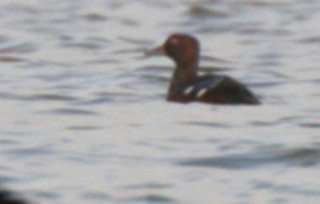
Steller's Eider (Photo: pp Steve Culley)
Thirty-one years ago this month, from the stage of the Winterland in San Francisco, John Lydon barked, in disconsolate fashion, "ever feel like you've been cheated?" as the Sex Pistols imploded. Well, last week's record of the female Steller's Eider "seen" in Wales may well have caused a few birders to think exactly that — they'd been cheated of a tank of fuel at least, as the whole story of what should have been one of the birds of the year unravelled and was dumped into the birding garbage bin. Pure and simple, it was a big wind-up. The ex-birder-turned-golfer seeing "a small sea duck" proved to be a fishy story too far for a few sleuthing Internet souls and a little bit of detective work rumbled the whole thing: the photo, supposedly taken in early January 2009 in north Wales, was actually taken in Finland in December 2006!
Ah well, someone somewhere has had a good laugh about it, settled a score perhaps, and has also, perhaps, set the template for future twitcher-duping. There's no doubt that technology can empower those wishing to set up hoaxes such as this, but technology can also be used to nip such things in the bud. A swift search of Google Images may help, for starters, if a rat is smelt. Technology has though, more importantly, taken away all of the charm of the old-fashioned, rather more entertaining, and almost quaint attempts of yesteryear. Of those nothing, but nothing, can better the Mann's-made mid–80s cardboard Siberian Thrush in Worcestershire (ask your dad!)
Photo of the Week

Barn Owl, undisclosed site, Lancashire (Photo: Damian Waters)
Barn Owls and Kestrels compete for the same prey species (mice, voles, etc.) in the same habitats so it's not surprising that this competition sometimes leads to aggression. In fact, in an interesting behavioural development, Kestrels have been observed robbing prey caught by Barn Owls. These aggressive interactions are more often witnessed than captured on camera but, this week, bird photographer Damian Waters managed to be in the right place at the right time. Damian's series of images clearly show that Kestrels have the upper hand in these clashes. Our pick of the series is this image showing a Kestrel with talons extended and bill agape almost touching the owl as the latter takes evasive action by diving sharply. A strong composition of diagonal lines gives the image an even more dynamic feel.
Other notable photos

Water Rail, Orrell Water Park, Manchester, Greater (Photo: David Cookson)

Waxwing, Musselburgh, Lothian (Photo: Ron McCombe)

Sanderling, Broadstairs, Kent (Photo: Tony Flashman)

Snowy Egret, United States (Photo: Tony Temple)

Barn Owl, Wiveton, Norfolk (Photo: Richard Bedford)

Black Grouse, Germany (Photo: Rudi Debruyne)

Reed Bunting, Titchwell RSPB, Norfolk (Photo: Ross Coupland)

Goldfinch, Rainham Marshes RSPB, London, Greater (Photo: Marcus Conway)

Marsh Harrier, India (Photo: Dave Williams)

Sparrowhawk, Llandrindod Wells, Powys (Photo: Kev Joynes)

Short-eared Owl, Silverwood Lagoons, South Yorkshire (Photo: Richard Layton)

Twite, Dingle Marshes SWT, Suffolk (Photo: Chris Mayne)
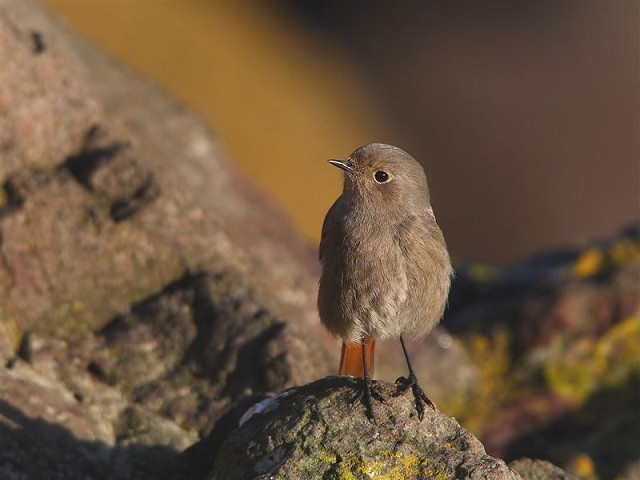
Black Redstart, North Berwick, Lothian (Photo: James Wood)

Teal, Belfast Lough RSPB, Antrim (Photo: Craig Nash)

Common Gull, New Brighton, Cheshire (Photo: Richard Steel)

Wren, Hickling Broad, Norfolk (Photo: Ross Coupland)

